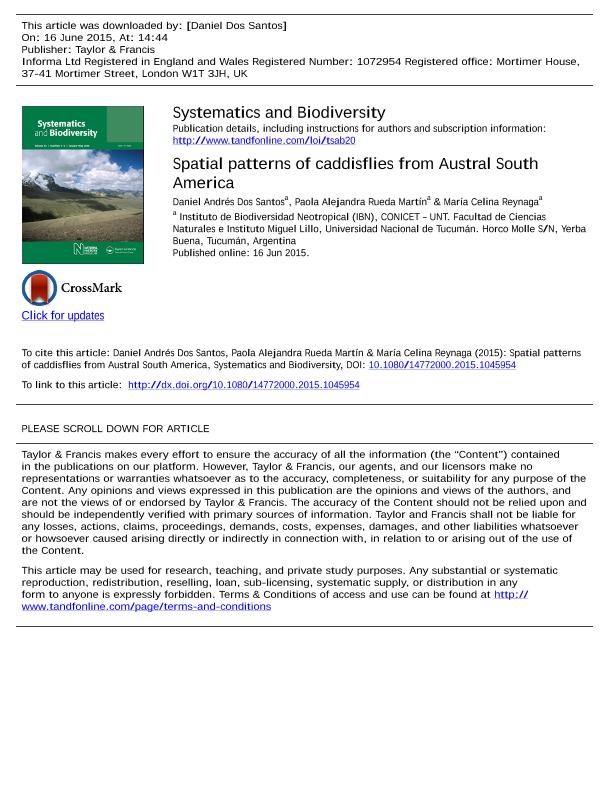Mostrar el registro sencillo del ítem
dc.contributor.author
Dos Santos, Daniel Andrés

dc.contributor.author
Rueda Martin, Paola Alejandra

dc.contributor.author
Reynaga, Maria Celina

dc.date.available
2017-02-07T18:43:55Z
dc.date.issued
2015-06
dc.identifier.citation
Dos Santos, Daniel Andrés; Rueda Martin, Paola Alejandra; Reynaga, Maria Celina; Spatial patterns of caddisflies from Austral South America; Taylor & Francis; Systematics And Biodiversity; 13; 5; 6-2015; 419-433
dc.identifier.issn
1477-2000
dc.identifier.uri
http://hdl.handle.net/11336/12672
dc.description.abstract
Trichoptera are relevant members of the freshwater benthos that can exploit a broad variety of habitats. We explored their distribution patterns in Austral South America using a network quantitative approach applied on point occurrence data. The primary goal was to recognize groups of species connected by strong links of sympatry and secondarily to evaluate the structure of the sympatry network (patterns of connectivity) at higher taxonomic levels. We compiled 2,522 geographic points associated with 446 species. The strength of sympatry links were inferred directly from dot maps. Using the taxonomic resolution of species, we identified two major groups of co-occurring species that mimic in a geographic context the classic zoogeographic division of the study area: the Andean–Patagonian complex (of “cold-adapted” organisms) versus the Extra-Andean domain (of “warm-adapted” organisms) spanning the subtropical belt of the region. Within these major divisions, groups of highly co-distributed species were also found which in turn show a variety of overlapping spatial configurations. Overlap was centred at the following pivoting areas: Yungas of NW Argentina, Paranaense forest of NE Argentina and Valdivian temperate forest of Patagonia. Three very interesting findings emerged from the analyses: (i) Sierras Centrales of Córdoba correspond to the southern portion of many subtropical elements occurring in NW Argentina, (ii) some elements fit the disjunction between NW and NE Argentina and (iii) Uruguay is more closely related to NE Argentina than to Buenos Aires, suggesting that the Pampas region (Uruguay + Buenos Aires) could be an ill-defined biogeographic entity. Patterns at the species level become progressively blurred in going upward through the hierarchical classification.
dc.format
application/pdf
dc.language.iso
eng
dc.publisher
Taylor & Francis

dc.rights
info:eu-repo/semantics/openAccess
dc.rights.uri
https://creativecommons.org/licenses/by-nc-sa/2.5/ar/
dc.subject
Aquatic Insects
dc.subject
Biogeography
dc.subject
Cleavogram
dc.subject
Nam
dc.subject
Trichoptera
dc.subject
Sympatry
dc.subject.classification
Otras Ciencias Biológicas

dc.subject.classification
Ciencias Biológicas

dc.subject.classification
CIENCIAS NATURALES Y EXACTAS

dc.title
Spatial patterns of caddisflies from Austral South America
dc.type
info:eu-repo/semantics/article
dc.type
info:ar-repo/semantics/artículo
dc.type
info:eu-repo/semantics/publishedVersion
dc.date.updated
2017-02-07T17:47:22Z
dc.identifier.eissn
1478-0933
dc.journal.volume
13
dc.journal.number
5
dc.journal.pagination
419-433
dc.journal.pais
Reino Unido

dc.journal.ciudad
Londres
dc.description.fil
Fil: Dos Santos, Daniel Andrés. Consejo Nacional de Investigaciones Cientificas y Tecnicas. Centro Cientifico Tecnologico Tucuman. Instituto de Biodiversidad Neotropical; Argentina. Universidad Nacional de Tucumán. Facultad de Ciencias Naturales e Instituto Miguel Lillo; Argentina
dc.description.fil
Fil: Rueda Martin, Paola Alejandra. Consejo Nacional de Investigaciones Cientificas y Tecnicas. Centro Cientifico Tecnologico Tucuman. Instituto de Biodiversidad Neotropical; Argentina. Universidad Nacional de Tucumán. Facultad de Ciencias Naturales e Instituto Miguel Lillo; Argentina
dc.description.fil
Fil: Reynaga, Maria Celina. Consejo Nacional de Investigaciones Cientificas y Tecnicas. Centro Cientifico Tecnologico Tucuman. Instituto de Biodiversidad Neotropical; Argentina. Universidad Nacional de Tucumán. Facultad de Ciencias Naturales e Instituto Miguel Lillo; Argentina
dc.journal.title
Systematics And Biodiversity

dc.relation.alternativeid
info:eu-repo/semantics/altIdentifier/doi/http://dx.doi.org/10.1080/14772000.2015.1045954
dc.relation.alternativeid
info:eu-repo/semantics/altIdentifier/url/http://www.tandfonline.com/doi/full/10.1080/14772000.2015.1045954
Archivos asociados
